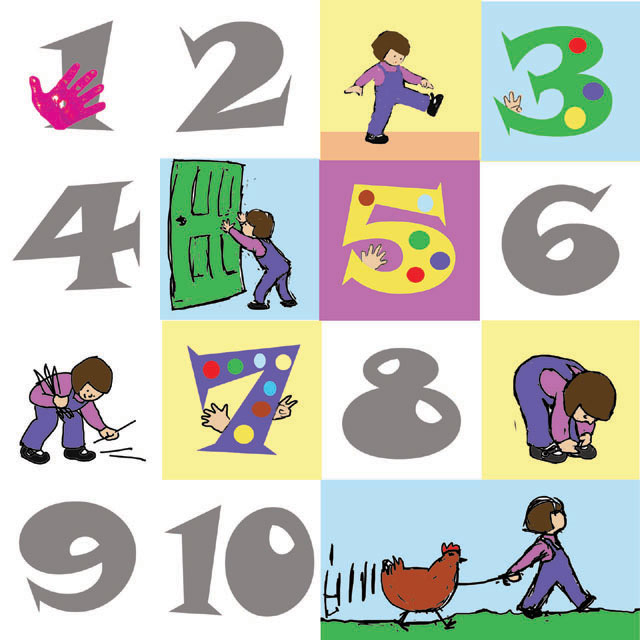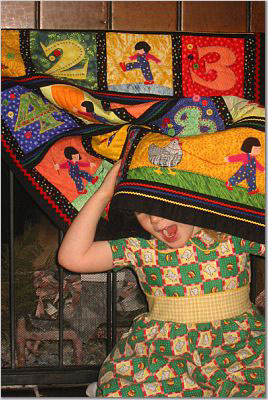Once the quilt had served it's purpose in the show, I gave it to my then two-year old granddaughter, Violet Grace. It was spring and I hung it on their fireplace screen, temporarily I thought, but Violet insisted that's where it went and refused to allow it to be removed until winter arrived and it had to go so they could have a fire. Meanwhile, several of her young friends visited and enjoyed counting the buttons and reciting the rhyme with her. Their enjoyment prompted my daughter Sarah to say, "Mom, that's a picture book."
Violet still loves her "chicken quilt", and though she did let me borrow it for a time while I was working on the book, now has it hanging in her room. When I showed her my first copy of the book she got a rather alarmed look on her face, hugged the book up, and ran to her room to make sure her own quilt was still there.
|
| Reviews:
 Kirkus April 15, 2008 Kirkus April 15, 2008
The simple old nursery rhyme is given vibrant life in this incandescent concept book. Hines, a gifted quilt artist, illustrates with her fabric art. Each number gets a full page: Numeral, background and frame appear in different fabrics, and embroidery, fancy stitching, rickrack and buttons (one for each number, adding a counting element) decorate. Some of the buttons are star- or heart- or flower-shaped; many of the fabrics are also patterned with flowers, stripes and geometrics in splendid saturated colors that pop off the paper. A small girl in star-covered overalls (and red shoes with buckles, of course) performs the actions indicated by the rhyme. This version ends with “My big fat hen!”—readers see the hen and child playing tug-o-war with a woolen thread. The last spread shows all the numbers one to ten, outlines of children’s hands and that array of buttons, one atop each digit allowing readers to count one, then two, then three, all the way up to ten. Joyous and great fun. (Picture book. 3-6)
 Booklist, May 2008 Booklist, May 2008
Illustrating the nursery rhyme "1,2, Buckle My Shoe," Hines uses fabric with an artist's eye, creating color and pizzazz through well-chosen fabrics, fancy stitching, and three-dimensional elements such as buttons and yarn. In half of the paired pictures, a little girl buckles her shoe, picks up sticks, and so on, while alternating sets of images boldly represent numerals, such as a large, blue "8" appliquéd to a yellow background, with eight buttons in different sizes and colors sewn on around the number. After a series of single-pages resembling quilt squares, the rhyme ends with two expansive double-page spreads, one illustrating the words "My big fat hen" and the other, all the numbers from one to ten. The jaunty endpapers carry photos showing hundreds of brightly colored buttons. Bold, simple layouts, the juxtaposition of printed fabrics, and the decorative use of rickrack and stitching make the playful art visually pleasing, but even better is Hines' fine-tuned understanding of how young children might use the book as they learn to count. Simple and striking. -- Carolyn Phelan
School Library Journal, May 2008
The popular verse, included in numerous collections of nursery rhymes, gets the star treatment in this delightful picture book. Illustrated entirely with quilt patches festooned with buttons, the ditty bounces along in bursts of color. The title page introduces the first patch—a little girl in star-covered overalls against a sunny yellow swatch of material, framed by a black border edged in rickrack and sewn upon a solid-color fabric. Then, each number is sewn on a separate quilt square, following the pattern set on the first page. The fabric designs vary, with each page more dazzling than the previous ones. Children will enjoy counting the buttons sewn beside the numbers. The text following each pair of numerals is set against it’s own patch, and opposite is a quilted picture of the girl acting out the verse. The last spread contains several pairs of hands adorned with buttons that match their corresponding numbers, 1 through 10. Youngsters who are just learning to count will enjoy poring over the cheerful pictures.—Martha Simpson
Seven Impossible Things Before Breakfast: Read a review on a fascinating blog about books by librarians Eisha and Jules.
|






